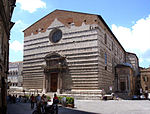Umbria
Regions of ItalyUmbria

Umbria ( UM-bree-ə, Italian: [ˈumbrja]) is a region of central Italy. It includes Lake Trasimeno and Marmore Falls, and is crossed by the River Tiber. It is the only landlocked region on the Apennine Peninsula. The regional capital is Perugia. The region is characterized by hills, mountains, valleys and historical towns such as the university centre of Perugia, Assisi (a World Heritage Site associated with St. Francis of Assisi), Terni, Norcia, Città di Castello, Gubbio, Spoleto, Orvieto, Todi, Castiglione del Lago, Narni, Amelia, Spello and other small cities.
Excerpt from the Wikipedia article Umbria (License: CC BY-SA 3.0, Authors, Images).Umbria
Piazza IV Novembre, Perugia Sant'Erminio
Geographical coordinates (GPS) Address Nearby Places Show on map
Geographical coordinates (GPS)
| Latitude | Longitude |
|---|---|
| N 43.1121 ° | E 12.3888 ° |
Address
Fontana Maggiore
Piazza IV Novembre
06122 Perugia, Sant'Erminio
Umbria, Italy
Open on Google Maps








